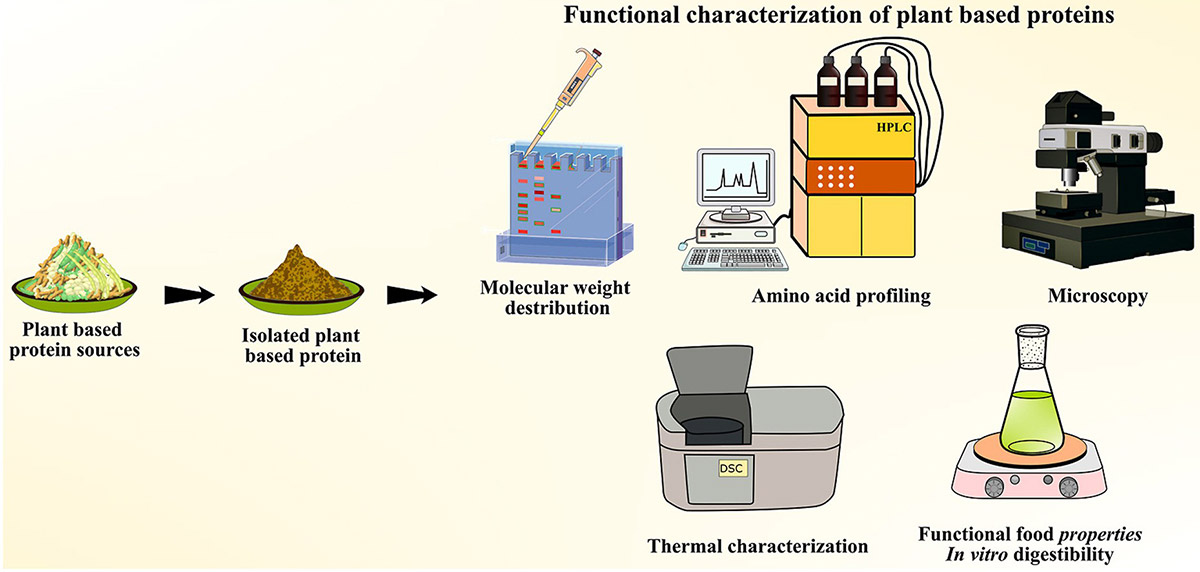The low protein content and lack of essential amino acids in plant proteins limit their functionality in foods, but different modification methods, such as chemical, physical, and enzymatic, enhance their functionality. Modifying plant proteins by different techniques alter their physicochemical and functional properties and address their limitations, providing opportunities to make them multifunctional components of food systems. However, some consumers avoid common plant proteins such as soy and gluten due to their potential allergenicity. Therefore, there is a need to understand the functional properties of these plant proteins and compare them to animal proteins that are more widely used in commercial products. Factors that currently influence the functional properties of plant proteins include variety, genotype, extraction method, drying method, protein level, and preparation method. Using plant proteins extracted from any fraction requires an exhaustive study of their functional properties and monomeric units (essential and non-essential amino acids).
 Fig. 1. Functional characterization of plant-based protein to determine its quality for food applications. (Kumar et al., 2022)
Fig. 1. Functional characterization of plant-based protein to determine its quality for food applications. (Kumar et al., 2022)
While plant proteins are highly regarded for their nutritional value, their functional properties are of great interest to the food processing industry. Lifeasible offers a variety of techniques to characterize the functional activity of plant proteins, including thermal stability, solubility, emulsification, foaming, water/oil uptake, and hydrophobicity. Our extensive experience allows us to gain insight into these functional properties and ensure their optimal use in food and nutritionally superior processed products.
Our functional activity analysis services for plant proteins include, but are not limited to:
Protein solubility directly affects various functional properties of plant proteins, such as emulsification and foaming. Lifeasible offers advanced methods to assess the solubility of plant proteins under different pH conditions. The process involves dispersing the protein powder in a buffer solution, adjusting its pH, and assessing the protein content after centrifugation. Through our detailed protocols, we ensure comprehensive standardization, promoting comparable results and precise accuracy.
The emulsification properties of plant proteins are affected by several factors, including the size, shape, flexibility, charge, hydrophobicity, and aggregation state of the protein molecule. Lifeasible offers several methods for measuring the emulsification properties of proteins, with the most common methods being emulsion activity and emulsion activity index. Both methods involve preparing an oil-in-water emulsion by dispersing a weighed protein into a buffer solution, which is mixed with a fixed amount of vegetable oil using a high-shear mixer.
Plant proteins stabilize foam by adsorbing to the air-water interface and forming a protective film around air bubbles. This is important for food applications that require a creamy or fluffy texture. Lifeasible can characterize the foaming properties of plant proteins by measuring foaming capacity and foam stability. Through rigorous churning methods and subsequent volumetric measurements, we help you determine the effectiveness of plant proteins as foam stabilizers.
We offer detailed methods for water and oil holding characterization of plant proteins. Proteins of known mass (g/g) are dispersed in distilled water or vegetable oil and then vigorously mixed. The resulting slurry is then centrifuged to remove excess water or oil. The difference in sample mass before and after centrifugation is calculated to determine how much water or oil the protein can hold.
The gelling properties of plant proteins are critical for food applications that require a semi-solid structure, such as plant-based meat, fish, eggs, or cheese products. Lifeasible offers various methods to measure plant proteins' gelling properties, including determination based on the minimum gelling concentration (LGC), texture profile analysis (TPA), dynamic shear rheology measurements, and more.
Understanding and predicting the functional properties of plant proteins can greatly simplify their application in food. At Lifeasible, we leverage the power of quantitative structure-activity relationship (QSAR) modeling and particle-based simulations (e.g., molecular dynamics simulations) to predict the functionality of plant proteins. These predictive models combine the strengths of both approaches to provide accurate tools for protein function prediction.
As the demand for plant-based products continues to grow, so does the importance of understanding these functions. At Lifeasible, our scientific expertise combined with state-of-the-art methodologies puts us at the forefront of plant protein functional activity analysis. Through our services, we are committed to utilizing the full potential of plant proteins to ensure their optimal performance and benefits in various applications. Please contact us for the best solutions.
Reference
Lifeasible has established a one-stop service platform for plants. In addition to obtaining customized solutions for plant genetic engineering, customers can also conduct follow-up analysis and research on plants through our analysis platform. The analytical services we provide include but are not limited to the following:
Get Latest Lifeasible News and Updates Directly to Your Inbox
Adaptive Evolutionary Mechanism of Plants
February 28, 2025
Unraveling Cotton Development: Insights from Multi-Omics Studies
February 27, 2025